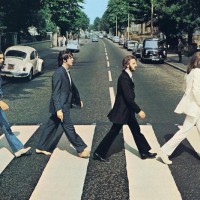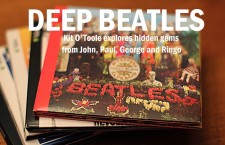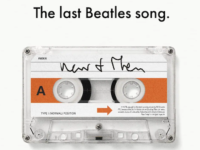One of the earliest and last tracks recorded for Abbey Road. The Beatles’ second entry into hard rock. Their final journey into the avant garde. Indeed, “I Want You (She’s So Heavy)” embodies these qualities, but it also provides a snapshot into John Lennon’s all-consuming relationship with Yoko Ono. Seething with sexual tension and featuring some of the band’s heaviest sound to date, the track demonstrates how much the Beatles had progressed in such a short time, willing to take risks in sound, form, and subject. A close examination of “I Want You” lifts the curtain on the creation process, showcasing how a song can take many twists and turns before appearing in its final form.
Expressing his life-engulfing passion for Ono, Lennon penned a track featuring only the words “I want you, I want you so bad, babe / I want you, I want you so bad it’s driving me mad, it’s driving me mad.” During his infamous 1971 Rolling Stone interview, Lennon addressed critics who panned his seemingly simplistic lyrics: “in fact a reviewer wrote … ‘He seems to have lost his talent for lyrics, it’s so simple and boring.’ ‘She’s So Heavy’ was about Yoko,” he said. “When it gets down to it, like she said, when you’re drowning you don’t say ‘I would be incredibly pleased if someone would have the foresight to notice me drowning and come and help me,’ you just scream. And in ‘She’s So Heavy,’ I just sang “I want you, I want you so bad, she’s so heavy, I want you,” like that.”
The lyrics may have been simple but the recording process was anything but. Lennon first brought the song “I Want You” to the Beatles on January 29 during the ill-fated Get Back sessions. Interestingly, at this stage Paul McCartney sang lead vocals. While he gamely sang the passionate words, he apparently could not capture the rawness that Lennon desired — although McCartney’s impressive bass lines can be heard clearly in this early take.
They returned to “I Want You” on February 22, recording an astounding 35 takes of the rhythm track at Trident Studios. In another early rehearsal, note Preston’s keyboards and some brief guitar solos.
Preston’s presence during the Get Back/Let It Be and Abbey Road sessions was clearly felt, and nowhere is it more evident than on this outtake. Preston sings with McCartney while playing gospel-tinged piano, further revealing the song’s initial R&B leanings. These elements would be somewhat muted in the final version.
The next day, the Beatles edited together parts of takes nine (early part), 20 (bridge), and 32 (remainder).
While taking a break from recording sessions, John Lennon and Yoko Ono married and spent their honeymoon staging the Amsterdam Bed-In. During this media event, composer and radio host Akiva Nof was invited to join them for an interview. At one point during the interview, Lennon played a selection from what he called “the Beatles’ new album,” specifically “I Want You.” Thus Voice of Israel listeners were given a sneak preview of Abbey Road (although Richie Unterberger points out in The Unreleased Beatles: Music & Film that Lennon may have been referring to the ultimately aborted Get Back at this stage) with Lennon adding the words “hello Israel” at the end. Singing while accompanying himself on acoustic guitar, this stripped-down version enables fans to hear the song’s deep blues roots. The latter part of the clip features a Get Back sessions outtake; note the different drum pattern, extra McCartney backing vocals, and Preston’s excellent organ contribution.
The Beatles’ work was not done, however. On April 18, Lennon and George Harrison created the massive finale. At EMI Studios they laid down multiple guitar tracks, creating the loud and powerful ending climax. Two more touches were added on April 20, when a Hammond organ part (courtesy of Billy Preston) and congas were overdubbed. I Want To Tell You author Anthony Robustelli created a mix that prominently features Preston’s Hammond Organ, Starr’s drums, McCartney’s funky bass, Harrison’s rhythm guitar, and the bongos overdub. One can appreciate how these individual ingredients combined to create the driving final version.
The same day the Abbey Road cover photo was taken — August 8 — the white noise effect and additional drum parts were added. Lennon created the white noise using Harrison’s brand-new Moog synthesizer; Ringo Starr contributed additional sounds using a wind machine found in the studio’s closet.
By August 11, the track was renamed “I Want You (She’s So Heavy),” and Lennon, Paul McCartney, and George Harrison recorded the “she’s so heavy” refrain twice, layering their vocals to deepen the sound. The final touch was the famous cut-off ending, which was added August 20. As assistant engineer Alan Parsons told Mark Lewisohn in the Complete Beatles Recording Sessions, Lennon requested that the song suddenly cut out. “We were putting the final touches to that side of the LP and we were listening to the mix. John said ‘There! Cut the tape there,’” Parsons recalled. “Geoff [Emerick] cut the tape and that was it. End of side one!”
As a side note, August 20 would hold a significant position in Beatles history: it marks the last time all four were in the studio.
The noise that ultimately drowns out the music, with the song abruptly cutting off, were intentional. Lennon wanted to achieve a massive sound, with the surprising ending suggesting that the song — as well as the ensuing desire — was never-ending. The Moog synthesizer, which also generated the white noise, achieved what Lewisohn calls “swirling, gale-force wind effect for the last three minutes of the song.”
Lennon’s decision to end the song in this manner reflects Ono’s avant garde leanings, specifically her professional relationship with composer John Cage. A pioneer of “noise music” (a subset of the Fluxus art movement), Cage challenged listeners to reconsider what constitutes music. For example, why can’t the sound of a whistling tea kettle or the popping sound of a toaster constitute music as much as the dulcet tones of a violin or horn? Karlheinz Stockhausen, another signifiant figure of the movement, essentially pioneered modern electronic music and also questioned the very notion of sound. Avant garde-leaning musicians in the 1960s were attracted to Stockhausen’s experiments in tape; his 1966 composition “Telemusik: may have directly influenced the ending of “I Want You,” as evidenced in the clip below.
Featuring a sound forecasting grunge — or, at the very least, John Lennon’s primal scream album — “I Want You (She’s So Heavy)” hardly represents a conventional love song. Alternating between jazz, blues and hard rock, the song describes all-consuming lust; however, its minor key and relentlessly churning ending suggests a darker tone to this obsession. Lennon directly addresses Yoko Ono in most of the lyrics, but suddenly changes to the third person in the “she’s so heavy” refrain. At this point, he addresses both the listener and himself, observing his deepening passion from another perspective. George Harrison’s lead guitar wails, emulating the narrator’s desperation and gradual surrender to his new love; Lennon emulates the guitar-powered melody in “I Want You,” elongating his voice on the last word as if bending a string.
Paul McCartney’s bass throbs throughout the track, enhancing the dark and, yes, heavy mood. He effortlessly navigates through the genres that encompass the song, as evidenced in this isolated bassline. It stands as one of his most underrated performances.
Then comes the three-minute climax, where the guitars crunch, the bass hits impossible lows, and Harrison, Lennon, and McCartney chant “she’s so heavy” like a mantra. As the white noise slowly floods the song, one can sense Lennon helplessly drowning in his emotions and his new love affair. The listener is bombarded with chugging rock and blues, increasingly disturbed by the disconcerting noise creeping through the music. When the cacophony comes to an abrupt halt, the listener (and, most likely, the Beatles) experience exhaustion; after all, “I Want You” has told a story through three distinct phases.
The first is a halting style, with Lennon expressing wonderment at his newfound desire. Next comes the jazz-tinged section, the sensually pulsating bass and drum pattern suggesting overwhelming sexuality. Last comes full throttle rock and roll with bass and (courtesy of the organ) a touch of gospel, describing the narrator sinking into the emotional quicksand. Instead of a smooth, gratifying ending, “I Want You” presents an unabashedly ambiguous one. As Alan Pollack writes in his Notes On series, the ending is “the intimation of an obsession upon which the mind zooms in on irresistibly, way past the point of comfort, very likely toward a breaking point or beyond.”
Upon Abbey Road’s 1969 release, Harrison praised Lennon’s ability to play with conventional musical forms — in this case, the blues. “The riff that he sings and plays is really a very basic blues-type thing. But again, it’s very original sort of John-type song – and the middle bit’s great,” Harrison said. “John has an amazing thing with his timing. He always comes across with sort of different timing things, for example ‘All You Need Is Love,’ which just sort of skips beats out and changes from three-four to four-four, all in and out of each other. But when you question him as to what it is, he doesn’t know. He just does it naturally. … The bridge section of this is a bit like that. And it’s got a really very good chord sequence that he uses.”
Expanding on Harrison’s assessment, “I Want You (She’s So Heavy)” showcases the Beatles’ past and present. It nods to their R&B beginnings, yet the avant garde touches and their upending of typical love song conventions indicate their mastery of transforming existing genres and forms into their own unique sound. “I Want You” may represent the last time the four were in the studio together, but it also symbolizes their last breakthrough in themes and, even more importantly, continuing the question posed by Cage and Stockhausen: What is music, anyway?
- The Rescued Early Paul McCartney Song That Completed ‘Beatles For Sale’ - December 4, 2024
- A Rare Beatles Cover Proves John Lennon Was Wrong About His Voice - November 26, 2024
- How John Lennon Came Roaring Back on the Beatles’ White Album - November 22, 2023





I have always thought of “She’s So Heavy” and “Oh! Darling” as rival songs by Lennon and McCartney, respectively. I can’t justify It based on the musical structure, however. I prefer “Oh! Darling.” Side 2 is the most important part of the album for me, and I usually remove Lennon’s “Sun King” “Mean Mr. Mustard” and “Polythene Pam.” They don’t have the emotional resonance and continuity that the McCartney compositions in the medley have.
McCartney seems underrated at times, I agree with his statements in recent interviews that there was “revisionism” after Lennon’s death. McCartney’s solo career was not very artistically serious, but with the Beatles I see him as the heavy lifter much of the time, and his bass playing is stunningly overlooked by many people. He may have been contemporaries with the one-and-only John Entwistle, but however impressive Entwistle’s playing is, it is not as emotionally expressive as McCartney’s.
Great piece thanks Kit.
Very good .very educational.thank you